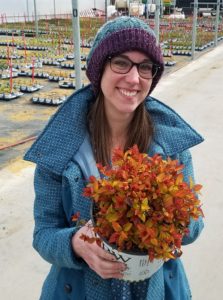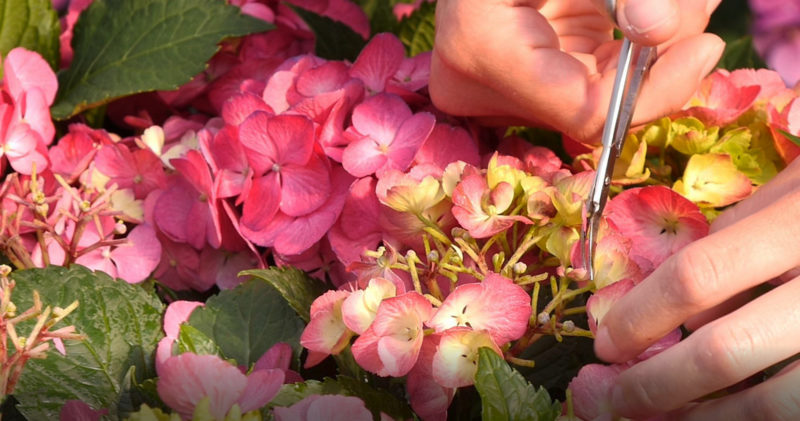Behind the Breeding
After earning my master’s degree in Plant Genetics from Oregon State in 2013, I moved to Michigan to join the New Product Development team at Spring Meadow Nursery. As our onsite plant breeder, I manage the development of new woody plants, and aid in their selection and evaluation.

We rely primarily on traditional breeding techniques: collecting pollen to make controlled crosses, placing selected parent plants in fly cages, and strategic plantings for open-pollinated seed collection. My team does a bit of chemical mutagenesis to aid in the development of sterile and less invasive cultivars. In addition, our tissue culture lab gives us the ability to embryo-rescue wide crosses or crosses that otherwise would not typically occur in nature, again aiding in the development of less invasive or sterile cultivars.
NOT JUST NEW, BETTER
One of the most-reported questions from consumers in garden centers is “What’s new?” That there is such interest in new plants is what drives our breeding program. However, if simply being new was good enough, we’d be introducing plants all day. My goal is to create plants with unique selling propositions that bring longevity and value to the market. We do this by making crosses, for which we collect seed and grow into 65,000 to 70,000 seedlings annually. This number is then reduced by sorting and rogueing. This process can begin as early at the cotyledon stage for traits like leaf color, and seedlings can be sorted for branch structure and vigor at an early stage as well.
BALANCE
After the remaining seedlings have grown on, we select the best among them for further evaluation. A selected plant may spend the next several years going through our evaluation process, which averages seven to 10 years. We compare every plant we evaluate to the current cultivars, along with other top cultivars in the market. It takes longer to develop and evaluate woody plants than herbaceous ones, but ultimately, if our selection is not an improvement, it’s just not worth it for us to introduce it. We discard a lot of good plants in our pursuit of the great.
One of the things I love most about breeding plants at Spring Meadow is working with a multitude of genera. We have over 70 unique genera in our trials at any one time. Even though it is nice to develop a new color range or a unique flower form, the part of breeding that is really exciting is to solve a problem and create a plant with stronger disease resistance and sterility, and for novel utility. Some of the groups I have most enjoyed working with and have made progress with include hydrangea, weigela, sambucus and forsythia.
Hydrangea macrophylla breeding has really taken off in the last 20 years with the introduction of remontant garden hardy varieties, so we apply some of the most stringent selection criteria on this crop. We run some of the most rigorous cold hardiness trials on Hydrangea macrophylla in North America by subjecting them to Zone 5 and 6 winters, coupled with specific trimming practices to replicate winter dieback, spring frost damage, and an early summer prune to test for remontant ability. In just the last seven years I have witnessed significant achievements in flower color and remontancy that will be changing the marketplace when they are introduced.

Weigela are one of my favorite plants to work with. They’re always popular with gardeners, and the large tubular flowers make controlled pollinations easy to perform. We’ve been making interspecific crosses in the hopes of bringing out never-before-seen qualities. Achieving germination has been an issue, however, so we’ve been using embryo rescue techniques to get them through that stage. It’s been an arduous but rewarding learning process.
Sambucus is just plain fun and has a unique feel to it. Recent introductions have brought with them chartreuse yellow foliage that doesn’t burn up in the sun, as well as upright forms straight out of a Dr. Seuss book. Foliage variation exists from lacy cut-leaf to broad, and colors from variegated green, yellow and burgundy. Making crosses among this variation has yielded very unique combinations, and though it needs more work, I think in the future one may see new combinations of all of these traits.
Forsythia breeding has been a recent breakthrough for me. For years, I was making crosses that never set any seed. Then I realized that the plants exhibit heterostyly: each plant differs in the placement of their sigma and anthers. Only plants of different placement can be crossed. We revaluated our parent material after this discovery and have made several successful crosses. Our goals include tamed habits, low growing types, and purple fall color to extend the season of interest for this spring-blooming favorite.








 Video Library
Video Library 

















